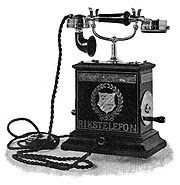The telephone is an electrical instrument. Speaking into the handset's transmitter or microphone makes its diaphragm vibrate. This varies the electric current, causing the receiver's diaphragm to vibrate. This duplicates the original sound. Take a look at this image to make this point much more clear.
Modern telephones don't use carbon in their handsets. They use electret microphones for the transmitter and piezoelectric transducers for receivers but the principle described in the image linked above is the same. Sound waves picked up by an electret microphone causes "a thin, metal-coated plastic diaphragm to vibrate, producing variations in an electric field across a tiny air gap between the diaphragm and an electrode."[Britannica definition] A piezoelectric transducer uses material which converts the mechanical stress of a sound wave upon it into a varying electrical signal.
Telephone history begins at the start of human history. Man has always wanted to communicate from afar. People have used smoke signals, mirrors, jungle drums, carrier pigeons and semaphores to get a message from one point to another. But a phone was something new. Some say Francis Bacon predicted the telephone in 1627, however, his book New Utopia only described a long speaking tube. A real telephone could not be invented until the electrical age began. And even then it didn't seem desirable. The electrical principles needed to build a telephone were known in 1831 but it wasn't until 1854 that Bourseul suggested transmitting speech electrically. And it wasn't until 22 years later in 1876 that the idea became a reality. But before then, a telephone might have been impossible to form in one's consciousness.
Subscribe to:
Post Comments (Atom)

No comments:
Post a Comment